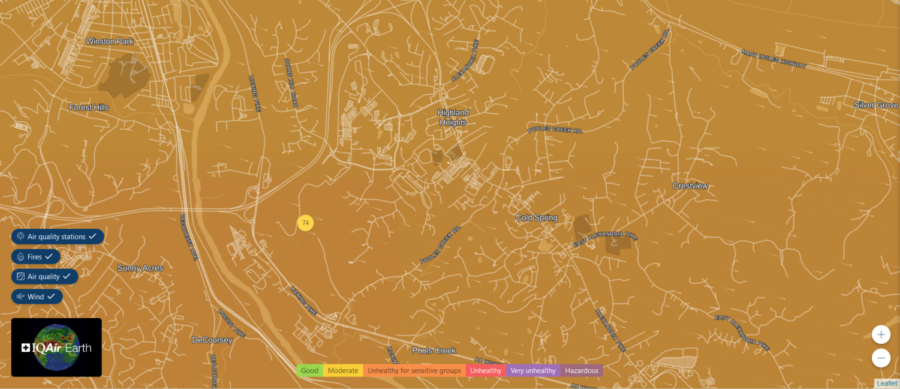How do the Canadian wildfires affect NKU?
An environmental scientist speaks on the danger of air pollution, measuring air quality and how people can protect themselves.
June 9, 2023
An outbreak of wildfires in Canada spewed dense smoke and haze into the sky this week, which was carried by the wind across the border into the United States. Air quality warnings have been issued in the Northeast down to the Midwest, cautioning people to remain indoors.
On and around the Northern Kentucky University campus in Highland Heights, the air quality measures at 76 on the US Air Quality Index (AQI) at the time of writing, according to the real-time air quality tracker IQAir. For comparison, the average air quality in Highland Heights is normally around 30.

The level of particulate matter (PM 2.5) in the area—extremely small particles 2.5 micrometers and smaller in diameter, or about a ten-thousandth of an inch—is nearly five times higher than the guideline value set by the World Health Organization.
The danger of these fine particulates lies in their size, according to Dr. Christine Curran, professor in biological sciences at NKU and toxicologist by training with a PhD in environmental health. Unlike larger particles that might get caught in our throats and cause coughing, PM 2.5 floats smoothly into our lungs and interferes with the flow of oxygen. Long-term exposure to PM 2.5 can affect brain development, making children especially vulnerable as their lungs are not yet fully developed and they have to breathe in more than adults.
Citing NKU’s laboratory research on genetic susceptibility to air pollutants, Curran said that as we inhale and ingest carbon-based air pollutants, whether from traffic fumes, wildfires or burning coal and wood, reactive metabolites might form in our bodies to remove the contaminants. The metabolites might stick to our DNA and damage it, complicating the process of DNA replication, eventually increasing the risk of birth defects and cancer.
Alongside children, people with respiratory conditions like asthma are also the most vulnerable to air pollution, Curran said. In terms of geography, populations that live near highways are more likely to be impacted, and air quality alerts trend toward the summer when the sun forms ozone. This combination exacerbates the air issues that follow the fires.
“With the wildfires, it’s mainly the smoke that’s causing the problem in the particulates, but we have an ongoing problem being in the Ohio Valley with both ozone and particulate pollution, because we have this sort of bowl in the valley in this ring of interstates that all come together,” Curran explained. “I-71 and I-75 come together—that slows down traffic. That congestion then causes more pollution in the center city and in these urban neighborhoods, and they have a higher rate of asthma and heart disease as a result.”
The AQI categorizes how polluted the air is through color coding. Green is safe and healthy, yellow means immunocompromised people will start experiencing discomfort, orange indicates increased health risk—and “by the time you get into the reds and the purples, it really doesn’t matter [what your health status is], everyone is at risk,” Curran said.
The haze will not linger in the area forever. When Curran was speaking with The Northerner, the wind was blowing in a northeast-southwest direction, carrying smoke and particulates into the Midwest. The pollution disperses if the wind shifts, the air pressures change or if a rain comes to wash the air clean. It is predicted that the haze will start dissipating over the coming days, Curran said.
She notes that the trees burning in Canada are primarily conifers, which tend to grow close together. The proximity of these trees, coupled with their thick, resinous sap, means that any fire breaking out would burn hot, burn fast and spread fast. Global warming further intensifies the wildfire season as hot, dry conditions arise more frequently, weather patterns become less predictable and a carbon loop is closed.
“Instead of pulling carbon dioxide out of the air, these forests as a burner just add tremendous amounts of carbon dioxide, carbon monoxide and other air pollutants—gasses like sulfur dioxide and nitrogen oxide—so it’s more particulates in that immediate area,” Curran said. “Any time you lose a forest to fire you’ve definitely complicated the climate change scenario.”
As of now, Curran echoes the advice of other experts to stay inside, use high-efficiency particulate air (HEPA) filters to capture the particulate matter—and change the filters regularly. She cautions against doing a lot of outdoor activities that are physically demanding, which means inhaling more particulate matter, and recommends wearing surgical and N95 masks if available.
She also wishes for others to think differently about climate change.
“We can’t just keep thinking of this as, ‘oh yeah, we had that hurricane and California burned and then we had mudslides—it happens’. No, it’s happening in the extreme, both in the severity of the event and the frequency of the event,” Curran added. “I wish [climate change] hadn’t become political. I wish they’d just let the scientists do their job. We’d be in a much better place.”
